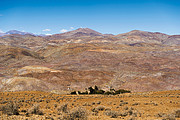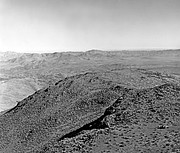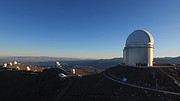Press Release
La Silla Observatory Turns 50!
ESO’s first observatory celebrates half a century of astronomical research
29 March 2019
Since its inauguration in 1969, ESO’s La Silla Observatory has been at the forefront of astronomy. Its suite of state-of-the-art instruments has allowed astronomers to make ground-breaking discoveries and paved the way for future generations of telescopes. Even after 50 years of observations, ESO’s telescopes at La Silla continue to push the boundaries of astronomy, discovering alien worlds and unveiling the cosmos in breathtaking detail.
Construction of La Silla on the summit of the Chilean mountain Cinchado-North in the outskirts of the Atacama desert, started in 1965, three years after ESO’s founding [1]. The site was chosen for its accessibility, dry climate, and ideal observing conditions — perfect for constructing a world-leading observatory.
Observations began using the relatively small ESO 1-m and ESO 1.52-m telescopes. The number and variety of telescopes on La Silla has increased as the observatory has matured, with the site now hosting 13 operating telescopes — not only from ESO but from countries, universities and collaborations around the world. These telescopes include TRAPPIST–South, the Rapid Eye Mount telescope (REM) and the TAROT telescope gamma-ray burst chaser.
Even 50 years after its inauguration, La Silla remains an ESO stronghold at the forefront of astronomy, providing the data for over two hundred papers each year. Though ESO’s flagship observatory is now the Very Large Telescope (VLT) at Paranal, ESO still operates two of the most productive 4-metre-class telescopes in the world at La Silla. ESO’s first major telescope, the ESO 3.6-metre, is home to the world's foremost extrasolar planet hunter — the High Accuracy Radial velocity Planet Searcher (HARPS), a spectrograph with unrivalled precision that has discovered scores of alien worlds.
The second ESO telescope still in operation at La Silla — the 3.58-metre New Technology Telescope (NTT) — broke new ground for telescope design and was the first in the world to have a computer-controlled main mirror. This innovative technology, called active optics, was developed at ESO and is now applied to most of the world's large telescopes. As well as performing a wide variety of scientific observations, this telescope was instrumental in paving the way for the VLT.
Both telescopes will receive upgrades to keep them at the astronomical vanguard. The NTT will soon host the pioneering SoXS instrument, a spectrograph designed to follow up transient and variable astronomical events from imaging surveys. The ESO 3.6-metre will host NIRPS, an infrared planet-hunting instrument that will complement the already impressive abilities of HARPS. These new arrivals, alongside new hosted telescopes like ExTrA and BlackGEM, will ensure that La Silla Observatory remains at the forefront of astronomical science.
Many of ESO’s top-ten discoveries were made using telescopes at La Silla. Highlights of the vast body of scientific research over the last five decades include: the discovery of the accelerating expansion of the Universe — a finding that earned the 2011 Nobel Prize in Physics; the discovery of a planet around the nearest star to the Sun; the observation of the first light from a gravitational wave source; the determination of the most accurate distances to nearby galaxies by the Chilean-led Araucaria project and the discovery of seven planets around an ultracool dwarf in the TRAPPIST-1 system.
Two particular astronomical events shook the routine of La Silla, and captured the attention of its armada of telescopes for weeks: the explosion of SN 1987A and the collision of comet Shoemaker-Levy 9 with Jupiter. The latter in particular disrupted life at La Silla, with 10 telescopes trained on Jupiter and live press events in Garching and Santiago sharing the latest developments in the cataclysmic collision with the media.
As well as its astronomical breakthroughs, La Silla has played an extremely important role in the development of astronomy in Chile, and Chilean astronomers routinely use telescopes in La Silla for their scientific research. The operation and continuous development of ESO facilities including La Silla has also provided a wide variety of opportunities for the involvement of Chilean industry, engineering and science. The telescopes of La Silla have also served as a training ground for new generations of European and Chilean astronomers, as shown for instance by the ESO-NEON Observing Schools that are regularly hosted at La Silla.
La Silla has endured challenges as well as enjoyed successes; while the observatory enjoys almost perfect observing conditions, it is also at risk of regular tectonic activity. No major problems have yet been caused by earthquakes at La Silla, despite occasionally being close to the epicentre of major earthquakes. The observatory now faces another troubling risk — light pollution from the nearby Pan-American Highway threatens La Silla’s dark skies.
As this distinguished observatory celebrates its fiftieth anniversary, it will advance not just professional but also amateur astronomy and widespread appreciation of astronomical phenomena — this year a total solar eclipse will be visible from La Silla. As the Moon covers the face of the Sun, turning day into night over a 150-km-wide swathe of northern Chile, hundreds of visitors will celebrate not only this rare astronomical event, but also the scientific legacy of La Silla, ESO’s original observatory.
Notes
[1] “La Silla” — Spanish for “The Saddle” — comes from the name local charcoal burners gave to Cinchado-North, the saddle-shaped mountain that became the site of ESO’s first observatory.
More information
ESO is the foremost intergovernmental astronomy organisation in Europe and the world’s most productive ground-based astronomical observatory by far. It has 16 Member States: Austria, Belgium, Czechia, Denmark, France, Finland, Germany, Ireland, Italy, the Netherlands, Poland, Portugal, Spain, Sweden, Switzerland and the United Kingdom, along with the host state of Chile and with Australia as a Strategic Partner. ESO carries out an ambitious programme focused on the design, construction and operation of powerful ground-based observing facilities enabling astronomers to make important scientific discoveries. ESO also plays a leading role in promoting and organising cooperation in astronomical research. ESO operates three unique world-class observing sites in Chile: La Silla, Paranal and Chajnantor. At Paranal, ESO operates the Very Large Telescope and its world-leading Very Large Telescope Interferometer as well as two survey telescopes, VISTA working in the infrared and the visible-light VLT Survey Telescope. Also at Paranal, ESO will host and operate the Cherenkov Telescope Array South, the world’s largest and most sensitive gamma-ray observatory. ESO is also a major partner in two facilities on Chajnantor, APEX and ALMA, the largest astronomical project in existence. And on Cerro Armazones, close to Paranal, ESO is building the 39-metre Extremely Large Telescope, the ELT, which will become “the world’s biggest eye on the sky”.
Links
- More information about La Silla
- Images of La Silla
- The 2019 Total Solar Eclipse at La Silla
- Article on the impact of Shoemaker-Levy 9 in The Messenger
Contacts
Calum Turner
ESO Public Information Officer
Garching bei München, Germany
Tel: +49 89 3200 6670
Email: pio@eso.org
Our use of Cookies
We use cookies that are essential for accessing our websites and using our services. We also use cookies to analyse, measure and improve our websites’ performance, to enable content sharing via social media and to display media content hosted on third-party platforms.
ESO Cookies Policy
The European Organisation for Astronomical Research in the Southern Hemisphere (ESO) is the pre-eminent intergovernmental science and technology organisation in astronomy. It carries out an ambitious programme focused on the design, construction and operation of powerful ground-based observing facilities for astronomy.
This Cookies Policy is intended to provide clarity by outlining the cookies used on the ESO public websites, their functions, the options you have for controlling them, and the ways you can contact us for additional details.
What are cookies?
Cookies are small pieces of data stored on your device by websites you visit. They serve various purposes, such as remembering login credentials and preferences and enhance your browsing experience.
Categories of cookies we use
Essential cookies (always active): These cookies are strictly necessary for the proper functioning of our website. Without these cookies, the website cannot operate correctly, and certain services, such as logging in or accessing secure areas, may not be available; because they are essential for the website’s operation, they cannot be disabled.
Functional Cookies: These cookies enhance your browsing experience by enabling additional features and personalization, such as remembering your preferences and settings. While not strictly necessary for the website to function, they improve usability and convenience; these cookies are only placed if you provide your consent.
Analytics cookies: These cookies collect information about how visitors interact with our website, such as which pages are visited most often and how users navigate the site. This data helps us improve website performance, optimize content, and enhance the user experience; these cookies are only placed if you provide your consent. We use the following analytics cookies.
Matomo Cookies:
This website uses Matomo (formerly Piwik), an open source software which enables the statistical analysis of website visits. Matomo uses cookies (text files) which are saved on your computer and which allow us to analyze how you use our website. The website user information generated by the cookies will only be saved on the servers of our IT Department. We use this information to analyze www.eso.org visits and to prepare reports on website activities. These data will not be disclosed to third parties.
On behalf of ESO, Matomo will use this information for the purpose of evaluating your use of the website, compiling reports on website activity and providing other services relating to website activity and internet usage.
Matomo cookies settings:
Additional Third-party cookies on ESO websites: some of our pages display content from external providers, e.g. YouTube.
Such third-party services are outside of ESO control and may, at any time, change their terms of service, use of cookies, etc.
YouTube: Some videos on the ESO website are embedded from ESO’s official YouTube channel. We have enabled YouTube’s privacy-enhanced mode, meaning that no cookies are set unless the user actively clicks on the video to play it. Additionally, in this mode, YouTube does not store any personally identifiable cookie data for embedded video playbacks. For more details, please refer to YouTube’s embedding videos information page.
Cookies can also be classified based on the following elements.
Regarding the domain, there are:
- First-party cookies, set by the website you are currently visiting. They are stored by the same domain that you are browsing and are used to enhance your experience on that site;
- Third-party cookies, set by a domain other than the one you are currently visiting.
As for their duration, cookies can be:
- Browser-session cookies, which are deleted when the user closes the browser;
- Stored cookies, which stay on the user's device for a predetermined period of time.
How to manage cookies
Cookie settings: You can modify your cookie choices for the ESO webpages at any time by clicking on the link Cookie settings at the bottom of any page.
In your browser: If you wish to delete cookies or instruct your browser to delete or block cookies by default, please visit the help pages of your browser:
Please be aware that if you delete or decline cookies, certain functionalities of our website may be not be available and your browsing experience may be affected.
You can set most browsers to prevent any cookies being placed on your device, but you may then have to manually adjust some preferences every time you visit a site/page. And some services and functionalities may not work properly at all (e.g. profile logging-in, shop check out).
Updates to the ESO Cookies Policy
The ESO Cookies Policy may be subject to future updates, which will be made available on this page.
Additional information
For any queries related to cookies, please contact: pdprATesoDOTorg.
As ESO public webpages are managed by our Department of Communication, your questions will be dealt with the support of the said Department.










